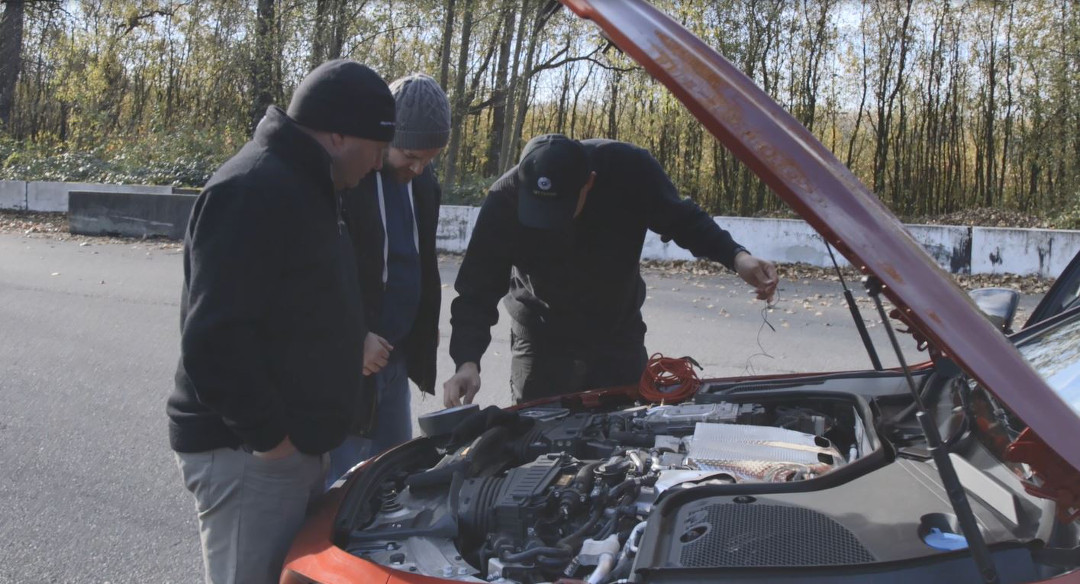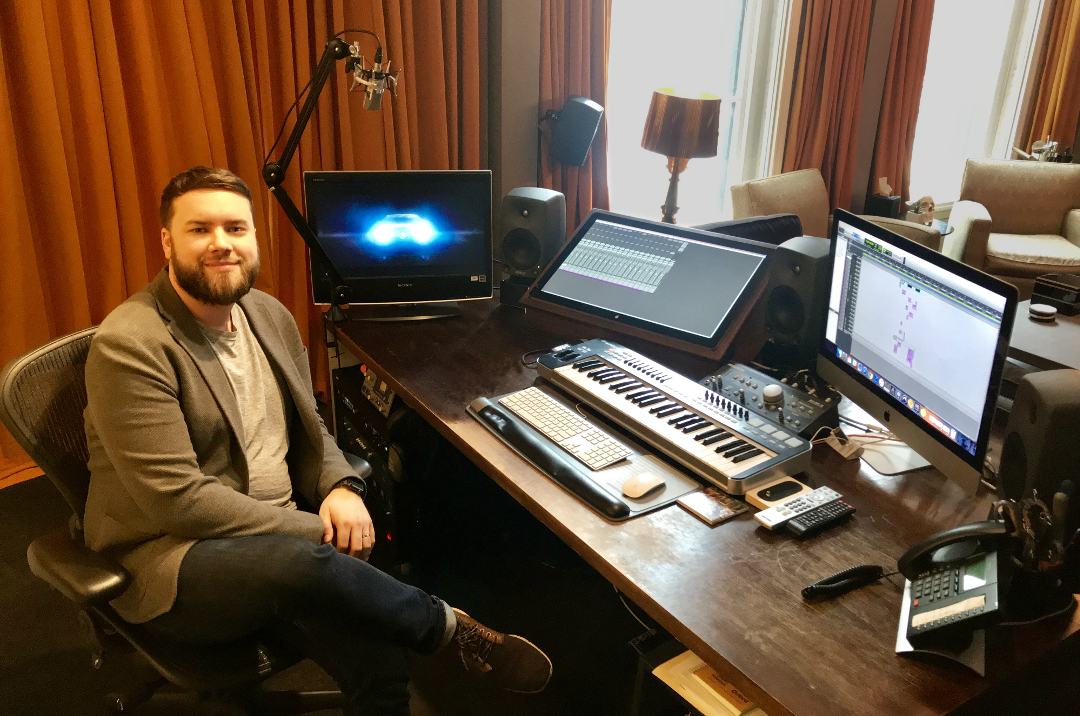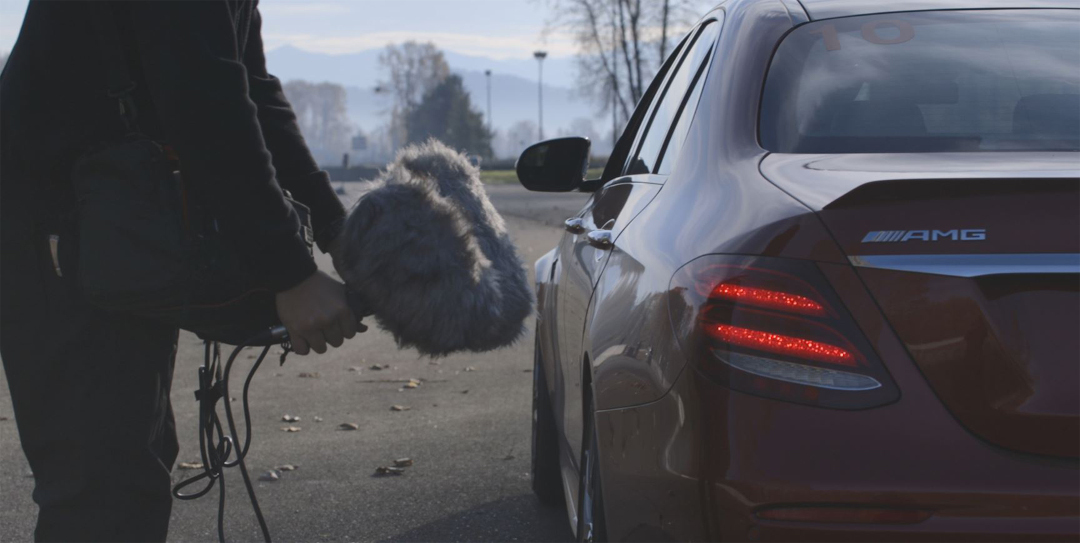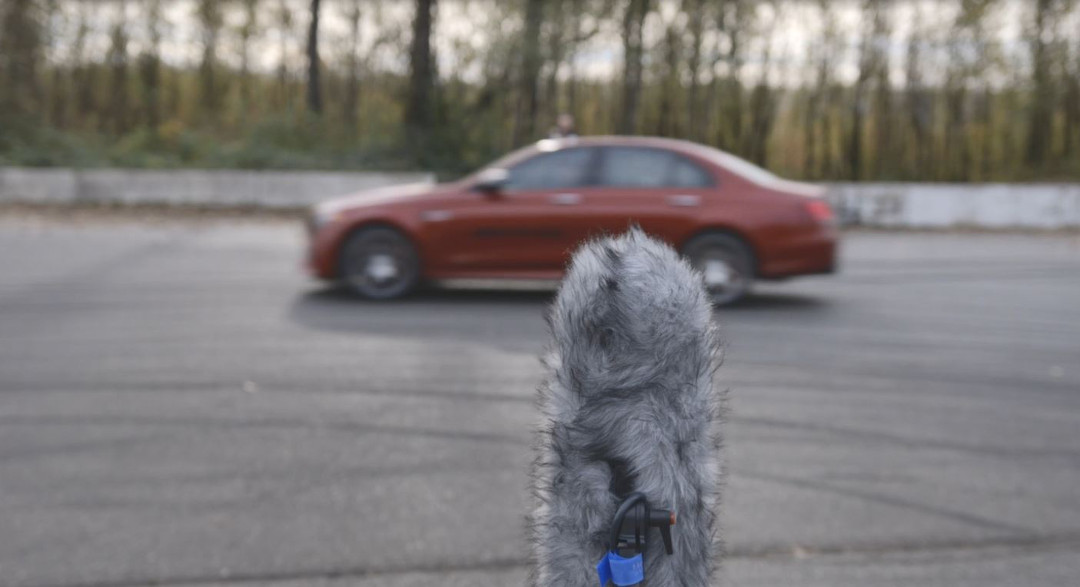Sound is the Star in this AMG-Mercedes Spot: An Audio Timeline from the Racetrack to Atmos
You never know when a diverse resumé is going to pay off.
Just ask Rob Ballingall, Mixer and Sound Designer for Nylon Studios in New York City. It turns out that growing up on a small island in the UK where he started out as a live sound engineer, becoming an audio archivist and transfer specialist, as well as a mastering engineer and music mixer, was a microcosm of what he could expect in an ear-shaking new Mercedes-AMG spot.
Ballingall was challenged to the max by “Hearing is Believing,” which was created by BBDO Canada and recently released to select 4DX and D-Box Cineplex Cinemas across Canada. The :30 spot puts sonics front and center, allowing the screen to go black as audiences are immersed by its soundtrack. Created with a big mic array that recorded a Mercedes-AMG E 63 S 4MATIC+ Sedan at the racetrack, the theaters’ D-Box capabilities (motorized movie seats) synchronize seat vibrations with sounds, and 4DX technology (simulating environmental conditions) generate the smell of spinning tires and bursts of wind as the car torches the unseen track around the audience. Only at the end does the vehicle become visible, coming to a full stop with one last snarl as it appears onscreen for a split second.
If you can’t experience it in a theater, put on your headphone to feel the power and spatial effects of “Hearing is Believing.”
In other words, sound is the star in this automotive tour de force. That explains why an audio person was actually the director for the spot, just one of four official hats that Ballingall wore including field recordist, editor and mixer. Along with the rest of the team at Nylon, Ballingall was aided by famed sound effects recordist Watson Wu (Baby Driver, ’71, Animal Planet).
A full-service music house set up to allow composers, sound designers and mixers work together seamlessly, Nylon’s comprehensive mindset made them well prepared to tackle the challenges of “Hearing.” From concept to field recording to a Dolby Atmos mix, Ballingall encountered plenty of left turns while creating this inspirational spot.
“Every aspect of it was nontraditional,” Ballingall laughs. “Typically when you’re working on a car commercial, you might get asked to show up to the shoot and get a couple of hours to record the car. For ‘Hearing,’ we were really acting as the production company from the start, so there were a lot more considerations. We’ve definitely done this sort of thing before, but the Mercedes-AMG spot was bigger.”
With ‘Hearing’, Nylon got the opportunity to trade in your usual car spot for a completely different narrative. “Usually when you see the car onscreen, it’s pretty obvious it’s a car commercial,” he points out. “When you don’t see it and you’re just hearing it, everything has to be on point for you to know the type of car that it is. You can tell that it’s luxurious, you can tell it’s fast, and the sort of driving that’s happening without any visual representation at all”.
“I think we ended up with something that’s as heavy as a racecar on the racetrack,” he continues. “We’re telling the story of the engine – the heart of the car – while always keeping the brand in mind. When you hear it in the movie theater, you really feel that aggression, which is integral to Mercedes-AMG’s goal of targeting a younger audience than their usual demographic.”
How does an extreme sound spot like this come together? Buckle your seatbelts: Ballingall has provided SonicScoop with an exclusive timeline to show how it all unfolded.
Rob Ballingall:
When BBDO Toronto initially approached us with this project, from an audio engineer’s perspective it was like we’d won the lottery. The idea of a car commercial driven (no pun intended) solely by audio was the dream stage for our work.
The goal was to prove to cinema-goers that nothing compares to a vehicle with an AMG engine by creating an in-theatre driving simulation, heightening their sense of sound by removing their sense of sight.
Our final delivery medium would be Dolby Atmos, as well as a binaural version for online.
Mercedes-Benz Canada provided us with two Mercedes AMG E63 S 4MATIC+ sedans, two different race tracks (both near chilly Vancouver, BC), and a precision driver. This gave us the tools we needed to capture the authentic sounds of an AMG engine.
Scripting Pure Sound: Initially, the agency creative team presented a number of “scripts” to us as ideas of how they’d like the audience to perceive the car’s movements around the theater. Based on those scripts, Stuart St. Vincent Welch (of Nylon Sydney) and I put together a number of demos, using sound effects from our own libraries, and mixed them in binaural with the Binauralizer from Noise Makers.
This gave us the ability to rough out timings for each script, getting a sense of how long each car maneuver would take, and giving the agency the option to show this to client for concept approval.
A minor bump in the road (pun intended) we encountered with this process was the limit of only a 30-second spot duration, causing a number of maneuvers to be omitted to maintain continuity with realistic driving speeds. Stuart and I used our own discretion to manipulate the scripts, making them as authentic as possible.
Our demos also gave us the information we needed to start formulating a tracking list, and we ended up with nearly 40 different sounds, including around 10 Foley sounds (engine starts and stops, doors, buttons, horns etc…) and 30 on-track maneuvers.
Field Recording – A Day at the Race Track: At this stage we brought Watson Wu onto the project, who is one of the best location sound recordists in the industry, and he specializes in automotive recording. Watson and I worked closely over the weeks leading up to the record to plot the day, discussing microphone selection and technique, and how those would translate up to the final Dolby Atmos mix.
We ended up taking a huge arsenal of microphones, including a Sennheiser Ambeo (yes, AMG doughnuts around the Ambeo!!!), Sennheiser MKH 416s and 30s, DPA 4017, a number of DPA 4061s, and an array of Shure dynamics.
To track it all we used multiple field recorders from Sound Devices, but their MixPre-10T stood out head and shoulders above the rest for me, and was fantastic for the four-channel Ambeo.
Expected/Unexpected: There were a couple of variables on the day of record that were beyond our control. For example, we had planned to record all the Foley, and some of the lower speed, smaller distance maneuvers, on a skidpan at the start of the day. On the day, it turned out we were sharing that sonic environment with a small airfield, police tactical driver training on an adjacent track, and some construction.
We had flagged the airfield prior to the shoot, and a location scout with an audio brain might have been able to call some of these issues in advance, but we had to roll with the tracks we had been provided. It’s also amazing how loud even the quietest real world environments are, even in rural British Columbia. We cut our losses on that track almost immediately, as we knew the other was more remote, with a much lower chance of extraneous noise. The second track was plagued by a very close railway line, but luckily the trains only ran through once every few hours.
Weather was another factor that we had to consider right from the start. Our production team coordinated with the agency to arrange for rain days, and Watson and I contemplated what, if any, we would be able to record in rain. We even proposed a “rain script” where we would play into the rain and exterior atmosphere more to enhance the immersion for the listener. Luckily, we only had a little wind, and some leaves on the tracks to deal with. Take note: leaf blowers are essential for track recordings in fall.
Another hurdle that came up, but mostly in post, was tire noise. Mercedes AMG engine vehicles are luxury sports cars, with phenomenal engine and exhaust tones, which needed to be the hero, not the tire squeal. To combat this, and give us plenty of options for the edit, we positioned mics inside the engine bay and air intake, inside the cab itself, and on the tail pipes. This gave me ultimate control of just how much engine, exhaust, and tire made it into the final mix.
Get it Edited: Upon returning to NYC, I was faced with the task of sifting through the audio we had captured to start creating our spot. Initially, I did this just in stereo, with no binaural element, wanting to focus on getting the right sounds and the right timings.
The agency joined me a day later, and we spent time reviewing and tweaking, so they could present the final edit (note edit, not mix) to Mercedes. With approval of the edit came the upmix to 5.1, and again a round of reviewing and tweaking with agency, and a presentation to Mercedes.
Fast Teamwork on the Immersive Mix: We gained 5.1 approval at around 4pm on a Tuesday afternoon, and had a scheduled final Dolby Atmos mix review with Mercedes the next morning at 10am (due to a tightened schedule). In comes Nylon Studios’ non-stop turnaround capabilities, and I was able to send my session over to Stuart in Sydney, for a first pass Dolby Atmos mix overnight.
My 5.1 was a loose guide showing the bones of where the car needed to be in the Atmos mix. Stuart took all the automated pan movements of my mix and translated them out into Dolby mix “objects,” giving us near pinpoint localization accuracy anywhere in the theatre, while leaving specific atmospheric and textural beds in the LFEs, and spread around the theater as necessary.
The mix objects also gave Stuart the ability to enhance the immersion of the “pass through” moments, where the car feels as though it’s driving right past you from front right, to rear left, with the growl of the engine sounding like nothing like you’ve ever heard before when played back on the Dolby Atmos system.
By the time I arrived at the final Dolby Atmos mix review (on this side of the globe), most of the leg work on the Atmos mix was done, so final tweaking with client happened rapidly. We wrapped the whole project from record, through edit and final mix in 10 days.
Up to Atmos: We mixed in 5.1, so what made this a 9.1 presentation?
Note that the proprietary “Dolby Atmos Cinema Sound” format does not have a traditional channel order associated with it. As such, we did this mix in a Dolby Atmos Certified Theatre mix stage in Toronto, with 64 speakers, where the “objects” can be (and are in our mix) placed in any speaker independently.
As there’s little standardization in cinema sound systems, when the Dolby Atmos files are encoded and exported, it automatically creates a 64 Speaker Atmos file (compatible with smaller 32 and 16 speaker Atmos cinemas), and downmixes for traditional 9.1, 7.1 and 5.1. This way, when the files are delivered to cinema, they will play on all Dolby cinema sound systems regardless of whether they are Dolby Atmos or traditional Dolby cinema sound. As I mentioned previously, we mixed in binaural and then up to 5.1 at Nylon, but the 5.1 mix was merely a guide for the end Atmos mix.
The 4DX elements were programmed by a company in South Korea, and both the D-Box and 4DX programmers needed the final audio to be able to complete.
How it Should Sound: Our bread and butter is commercial mixing; and the dynamic range of mixes for TV broadcast is nowhere near that of what you can retain for cinema, so I wanted to keep a lot of dynamic range in our mix.
This meant that our dramatic moments, such as the engine start and rev, the pass throughs, and the final huge rev really are massive, but also give the audience the sense of space. You really can tell exactly where the car is, but also how far away it is on the two power slide turns. I believe this enhances authenticity by forcing the listener to imagine the car around them, rather than actually seeing it.

It took teamwork: “Hearing is Believing” is the rare spot where audio tells virtually the entire story.
It’s common that I’ll go out into real world with a Zoom H4n and capture some ambience, or jump in the booth to record foley for a spot, but we rarely get the opportunity to undertake a project of this scale, and certainly never this creative direction, so hats off to our BBDO friends, for taking the chance, and Mercedes-Benz for backing it.
Too often audio is the last component of a project, and while not an oversight, it’s common that less emphasis is put on its ability to support the narrative…but rarely and excitedly in this case, audio is the narrative.
Please note: When you buy products through links on this page, we may earn an affiliate commission.









